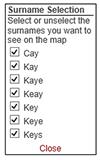Yorkshire Names in 1841
Our feeling is that the spelling of the name had yet to stabilise in 1841; we all find cases where different spellings were applied to the same person at various times. At a time when the level of literacy was still low, much of it may have been down to the enumerator’s own idea of how the name should be spelt. But there was a significant number of cases, more so than in Lancashire, when more than one spelling was used in the same return. It can’t all be put down to inconsistency.
This map shows the different spellings. Hover over a wapentake (or touch it if you’re using a touch sensitive screen) to see the names and their frequency.
 The information box that’s displayed when you hover over a wapentake carries a lot of information. Its aim is to show how many people lived in the wapentake, and what spellings were used. The first line shows the total number in the wapentake (all spellings), and the percentage of the total across Yorkshire that represents. The other lines show each of the spellings of the names we’re looking at, and how often they occur. The percentage is based on the total for that name across Yorkshire.
The information box that’s displayed when you hover over a wapentake carries a lot of information. Its aim is to show how many people lived in the wapentake, and what spellings were used. The first line shows the total number in the wapentake (all spellings), and the percentage of the total across Yorkshire that represents. The other lines show each of the spellings of the names we’re looking at, and how often they occur. The percentage is based on the total for that name across Yorkshire.
 You can change the names being shown on the map by clicking on the ‘Select names’ link at the bottom of the key. The box shown is simply a list of the names this map covers. Click on the tick boxes to include or exclude names to examine the ones you’re interested in. The changes will be reflected immediately on the map and you can still hover over a wapentake to examine the breakdown. We hope this will give you the chance to do your own investigation into that contentious issue of the different spellings and where they came from.
You can change the names being shown on the map by clicking on the ‘Select names’ link at the bottom of the key. The box shown is simply a list of the names this map covers. Click on the tick boxes to include or exclude names to examine the ones you’re interested in. The changes will be reflected immediately on the map and you can still hover over a wapentake to examine the breakdown. We hope this will give you the chance to do your own investigation into that contentious issue of the different spellings and where they came from.
Kay and Kaye
Having said that, it is clear that Kaye and to a lesser extent Key were concentrated in the West Riding. The following table shows those parishes where we find what seem to be the most significant variations in spelling – the figures shown are a count of the number of occurrences of the name, with the percentage of the total for that spelling given in brackets:
Summary
As a brief summary, here are the totals across the whole county.